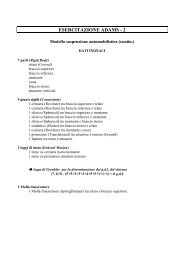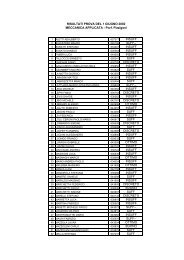Semmering Railway - Wikipedia, the free encyclopedia
Semmering Railway - Wikipedia, the free encyclopedia
Semmering Railway - Wikipedia, the free encyclopedia
You also want an ePaper? Increase the reach of your titles
YUMPU automatically turns print PDFs into web optimized ePapers that Google loves.
Atchison, Topeka and Santa Fe <strong>Railway</strong> - <strong>Wikipedia</strong>, <strong>the</strong> <strong>free</strong> <strong>encyclopedia</strong><br />
on December 23, 1873. The Santa Fe's tracks reached Pueblo, Colorado on March 1, 1876. Serving Pueblo<br />
opened a number of new freight opportunities for <strong>the</strong> railroad as it now could haul coal from Colorado<br />
eastward.(Early history)[1]<br />
Building across Kansas and eastern Colorado may have been technologically simple as <strong>the</strong>re weren't many<br />
large natural obstacles in <strong>the</strong> way (certainly not as many as <strong>the</strong> railroad was about to encounter fur<strong>the</strong>r west),<br />
but <strong>the</strong> Santa Fe found it almost economically impossible because of <strong>the</strong> sparse population in <strong>the</strong> area. To<br />
The Santa Fe trademark in combat this problem, <strong>the</strong> Santa Fe set up real estate offices in <strong>the</strong> area and vigorously promoted settlement<br />
<strong>the</strong> late 1800s incorporated across Kansas on <strong>the</strong> land that was granted to <strong>the</strong> railroad by Congress in 1863. The Santa Fe offered<br />
<strong>the</strong> British lion out of<br />
respect for <strong>the</strong> country's discounted passenger fares to anyone who travelled west on <strong>the</strong> railroad to inspect <strong>the</strong> land; if <strong>the</strong> land was<br />
subsequently financial assistance purchased in by <strong>the</strong> traveller, <strong>the</strong> railroad applied <strong>the</strong> passenger's ticket price toward <strong>the</strong> sale of <strong>the</strong> land. Now that <strong>the</strong> railroad<br />
building <strong>the</strong> railroad to<br />
had built California. across <strong>the</strong> plains and had a customer base providing income for <strong>the</strong> firm, it was time to turn its attention toward <strong>the</strong> difficult<br />
terrain of <strong>the</strong> Rocky Mountains.<br />
Crossing <strong>the</strong> Rockies<br />
Leadville was <strong>the</strong> most productive of all of <strong>the</strong> Colorado mining regions. Mining in <strong>the</strong> area<br />
began in 1859, first for gold and <strong>the</strong>n two decades later for silver. Several of <strong>the</strong> Santa Fe's<br />
board of directors (along with President Strong) sought to capitalize on <strong>the</strong> need to supply <strong>the</strong><br />
mining towns of Colorado and nor<strong>the</strong>rn New Mexico with food, equipment, and o<strong>the</strong>r<br />
supplies. To that end, Santa Fe sought to extend its route westward from Pueblo along <strong>the</strong><br />
Arkansas River, and through <strong>the</strong> Royal Gorge in 1877. Royal Gorge was a bottleneck along<br />
<strong>the</strong> Arkansas too narrow for both <strong>the</strong> Santa Fe and <strong>the</strong> Denver and Rio Grande Western<br />
Railroad to pass through, and <strong>the</strong>re was no o<strong>the</strong>r reasonable access to <strong>the</strong> South Park area;<br />
thus, a race ensued to build rail access through <strong>the</strong> Gorge. Physical confrontations led to two<br />
years of armed conflict, essentially low-level guerrilla warfare between <strong>the</strong> two companies<br />
that came to be known as <strong>the</strong> Royal Gorge Railroad War. Federal intervention prompted an<br />
out-of-court settlement on February 2, 1880 in <strong>the</strong> form of <strong>the</strong> so-called "Treaty of Boston"<br />
wherein <strong>the</strong> D&RG was allowed to complete its line and lease it for use by <strong>the</strong> Santa Fe. The<br />
D&RG paid an estimated $1.4 million to Santa Fe for its work within <strong>the</strong> Gorge and agreed<br />
not to extend its line to Santa Fe, while <strong>the</strong> AT&SF agreed to forgo its planned routes to<br />
Denver and Leadville.<br />
The D&RG mainline through <strong>the</strong> Royal Gorge<br />
in 1881.<br />
Also looking to <strong>the</strong> south, an initial outlay of $20,000 was authorized on February 26, 1878 for <strong>the</strong> construction of a rail line south from<br />
Trinidad in order to "..seize and hold Raton Pass." The location of <strong>the</strong> route was nearly as crucial to <strong>the</strong> venture's success as was <strong>the</strong> actual<br />
track construction. W. R. "Ray" Morley, a former civil engineer for <strong>the</strong> (D&RG) hired by <strong>the</strong> AT&SF in 1877, was given his first<br />
assignment to secretly plot a route through <strong>the</strong> pass (it was feared that any activity in <strong>the</strong> area would lead <strong>the</strong> D&RG to construct a narrow<br />
gauge line over <strong>the</strong> Pass). Additionally, Strong learned that <strong>the</strong> Sou<strong>the</strong>rn Pacific Railroad (SP) had introduced legislation to block <strong>the</strong> Santa<br />
Fe's entry into New Mexico. Undaunted, Strong obtained a charter for <strong>the</strong> New Mexico and Sou<strong>the</strong>rn Pacific Railroad Company and<br />
immediately sent A. A. Robinson to Raton Pass. From February to December of 1878 work crews struggled to build <strong>the</strong> line between La<br />
http://en.wikipedia.org/w/index.php?title=Atchison%2C_Topeka_and_Santa_Fe_<strong>Railway</strong>&printable=yes (3 of 16)22/04/2007 16.25.04









